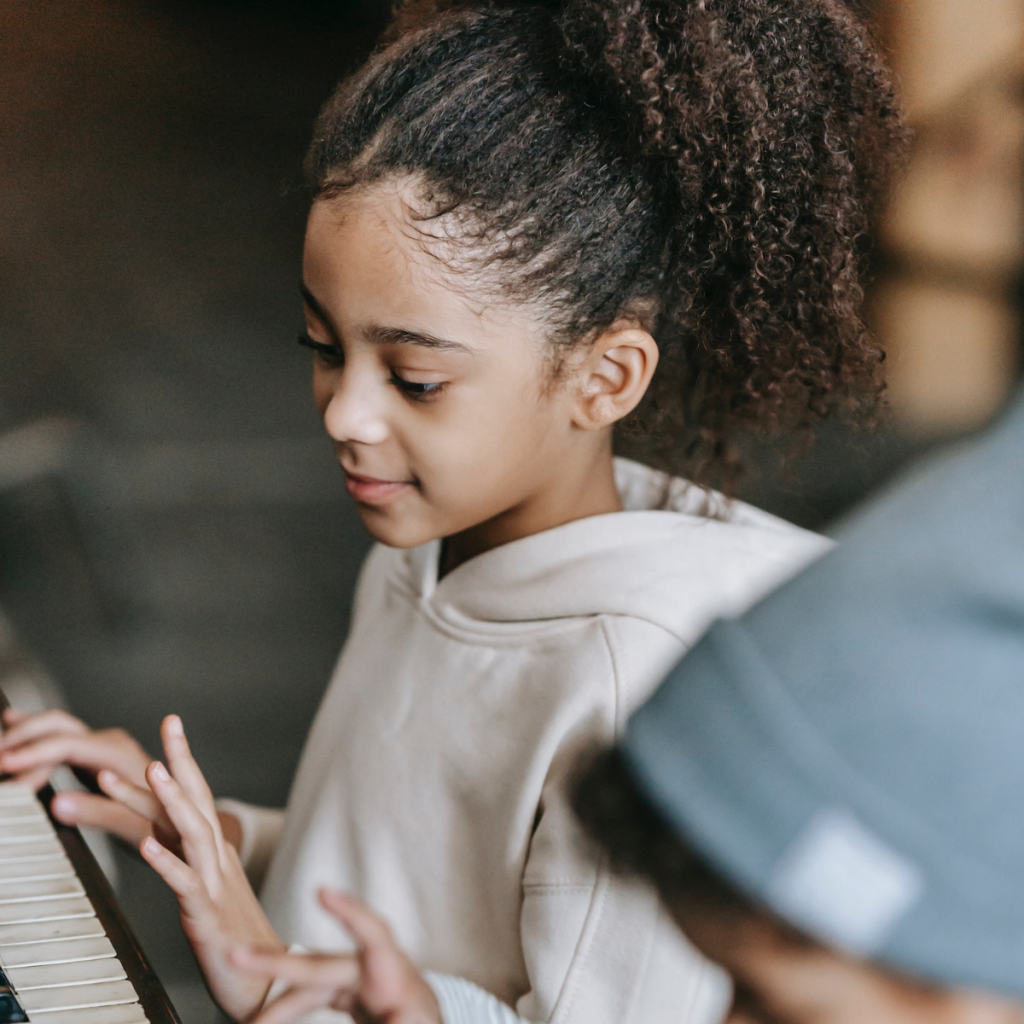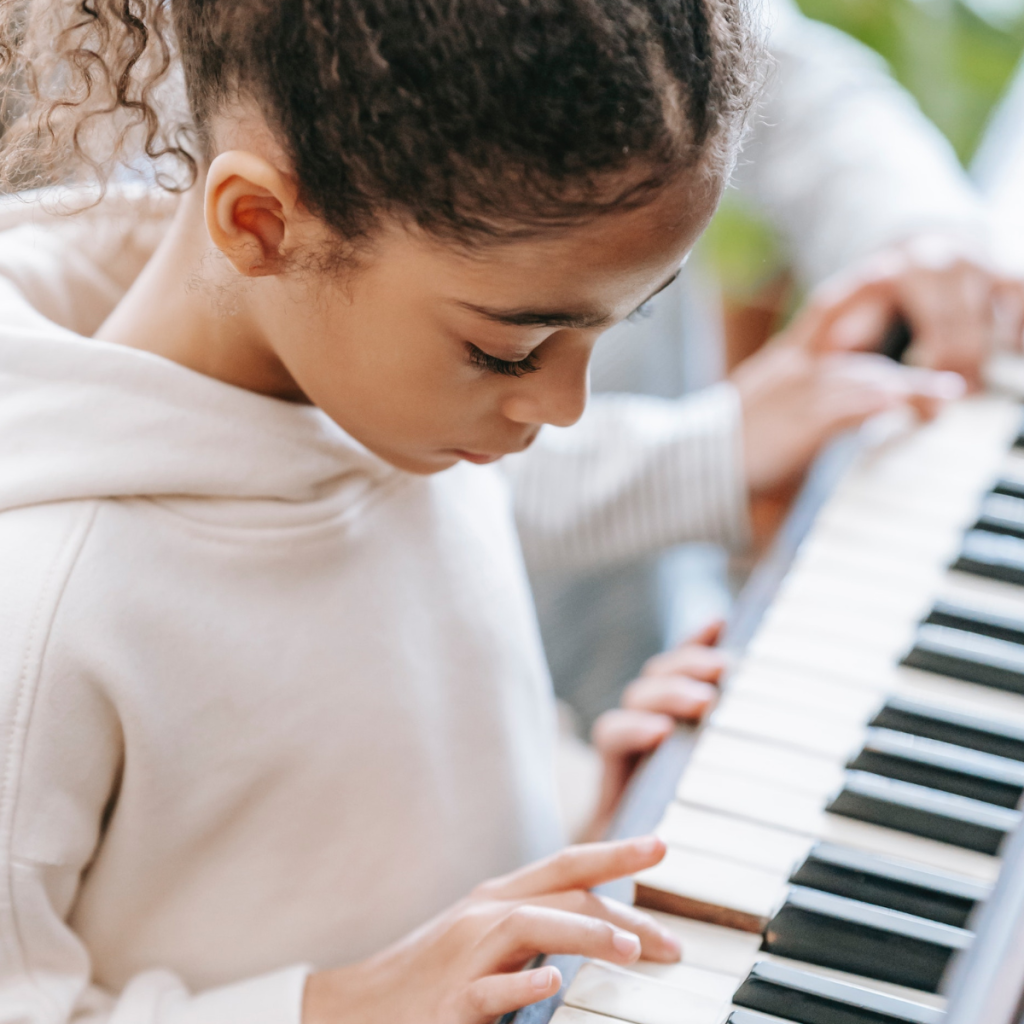Discover effective strategies and tips on how to teach a 6-7 year old child to play a musical instrument.
How to Teach a 6-7 Year Old Child to Play an Instrument
Learning to play a musical instrument is a wonderful way for children to explore their creativity and develop valuable skills. If you have a 6-7 year old child who shows an interest in music, you might be wondering how to go about teaching them. In this article, we will discuss various strategies and techniques to help you guide your little one through this exciting musical journey.
Understanding the Learning Capabilities of a 6-7 Year Old

Before diving into the world of music education, it’s essential to understand the cognitive and physical development of children in this age group.
At the age of 6-7, children are at a crucial stage of cognitive development. They are expanding their thinking abilities and are capable of more complex cognitive tasks. They can follow instructions, recognize patterns, and engage in more advanced problem-solving activities. However, it’s important to note that they still thrive on concrete examples and a hands-on learning approach.
When it comes to music education, incorporating interactive and engaging activities is key to making the learning process enjoyable for your child. One effective strategy is to use games and visual aids to introduce different musical notes. For example, you can create colorful flashcards with musical notes and have your child match them to the corresponding sounds. This not only helps them learn the basics of music but also enhances their cognitive skills.
Furthermore, encouraging your child to identify patterns in a song can be a fun and educational activity. You can play different songs and ask them to identify recurring melodies or rhythms. This not only develops their cognitive abilities but also helps them develop a deeper appreciation for music.
Physical Skills and Coordination
In addition to cognitive development, 6-7 year olds are also experiencing significant improvements in their physical skills and coordination. They are becoming more physically adept and have better control over their movements. However, it’s important to note that their fine motor skills are still developing.
When choosing an instrument for your child, it’s crucial to consider their physical abilities. Instruments like the piano, keyboard, or ukulele are excellent choices as they require less finger dexterity compared to instruments like the violin or flute. Starting with a more accessible instrument allows your child to experience early success and build confidence in their musical abilities.
Playing a musical instrument not only enhances physical coordination but also improves hand-eye coordination and fine motor skills. The act of pressing keys or strumming strings requires precise movements, which helps develop and refine their motor skills.
Additionally, learning to play an instrument at this age can have a positive impact on their overall physical development. It promotes good posture, proper breathing techniques, and strengthens their hand muscles. These physical benefits further contribute to their overall growth and well-being.
Choosing the Right Instrument for Your Child
Now that you have an understanding of your child’s capabilities, it’s time to select the perfect instrument for them.
Choosing an instrument for your child is an exciting and important decision. Not only will it introduce them to the world of music, but it can also help develop their cognitive and motor skills. However, with so many options available, it can be overwhelming to know where to start.
Factors to Consider
When deciding on an instrument, consider your child’s interests and preferences. If they have a particular affinity for a specific instrument, it can serve as a great starting point. For example, if your child is always tapping their feet to the beat of a song, they may have a natural inclination towards drums or percussion instruments.
Additionally, think about the practicality of the instrument in terms of size, cost, and noise level. You want to choose something that your child can comfortably handle and that fits within your budget. If you live in an apartment building with thin walls, you may want to consider instruments that have a lower noise level, such as a keyboard or a ukulele.
Another factor to consider is the availability of lessons and resources for the chosen instrument. It’s important to ensure that your child will have access to a qualified teacher and learning materials to support their musical journey.
Popular Instruments for Beginners
For beginners in this age group, instruments like the piano, keyboard, guitar, ukulele, recorder, and drums are often recommended. These instruments offer a good balance between ease of use and musical versatility.
The piano and keyboard are excellent choices for young beginners as they provide a solid foundation in music theory and help develop finger dexterity. The guitar and ukulele are great options for children who enjoy strumming and singing along to their favorite songs.
The recorder, a small woodwind instrument, is often taught in schools and is a good introduction to playing wind instruments. It’s relatively easy to learn and can help your child develop their breath control and finger coordination.
Drums, on the other hand, offer a unique and energetic experience. They allow children to explore rhythm and coordination while having a blast making beats. However, it’s important to consider the noise level and the space required for a drum set.
Take your child to a music store and let them try out different instruments. Seeing their excitement and natural inclination towards certain instruments will help in making the final decision. Encourage them to experiment and explore different sounds, as this will help them connect with the instrument on a deeper level.
Remember, the most important thing is to choose an instrument that your child is passionate about. When they are genuinely interested in the instrument, they will be more motivated to practice and improve their skills. So, take your time, explore the options, and enjoy the process of finding the perfect instrument for your child.
Creating a Positive Learning Environment
Once you’ve chosen the instrument, creating a positive and supportive learning environment is essential for your child’s progress and enjoyment.
When it comes to learning an instrument, it’s not just about the technical aspects. It’s important to make the whole experience fun and engaging for your child. By incorporating music-related activities beyond the instrument itself, you can spark their curiosity and help develop their musical ear. Singing, dancing, and listening to a variety of genres can open up a whole new world of musical exploration for your child.
One way to make learning fun is to incorporate games and challenges into their practice sessions. For instance, you can create a musical scavenger hunt where they have to find and identify different instruments. This not only adds an element of excitement to their learning journey but also helps them develop a deeper understanding of the various instruments and their sounds.
Another way to keep their interest levels high is to let them unleash their creativity by allowing them to create their own compositions. This not only gives them a sense of ownership over their music but also encourages them to think critically and experiment with different musical ideas.
Encouraging Consistent Practice
Consistency is key when it comes to learning an instrument. Establishing a regular practice routine is crucial for your child’s progress. However, it’s important to ensure that this routine seamlessly fits into their daily schedule.
One way to encourage consistent practice is by breaking it down into smaller, manageable increments. Instead of expecting your child to practice for hours on end, consider setting aside shorter practice sessions throughout the day. This not only prevents them from feeling overwhelmed but also allows them to focus better during each practice session.
As a parent, it’s important to provide your child with the necessary support and encouragement. Praise their progress and celebrate milestones along the way. Recognizing their achievements, no matter how small, can boost their confidence and motivate them to continue working hard.
Setting achievable goals can also help keep your child motivated. Break down their musical journey into smaller milestones and reward them when they achieve these goals. Whether it’s a special treat or a fun outing, these rewards can serve as a reminder of their progress and keep them excited about their musical endeavors.
Basic Music Theory for Kids
Introducing your child to basic music theory concepts will help them understand the fundamentals of music and lay a solid foundation for their musical journey.
Music is a universal language that has the power to evoke emotions, tell stories, and bring people together. By teaching your child music theory, you are giving them the tools to unlock this magical world of sound and expression.

Introducing Notes and Rhythms
Start by teaching your child about musical notes and their corresponding timings. You can use visual aids, such as flashcards or colorful charts, to make it more engaging.
Notes are the building blocks of music. Each note represents a specific pitch or sound. By learning the names and durations of different notes, your child will be able to read and play music.
But music is not just about the pitch; it’s also about the rhythm. Rhythm gives music its groove and helps us feel the beat. Teach your child about different rhythm patterns and how they can be represented using musical notation.
To make the learning process more interactive, incorporate clapping or tapping exercises. This will help reinforce their understanding of timing and rhythm. Encourage them to create their own rhythms and have fun exploring different beats.
Understanding Scales and Chords
Once your child has a grasp on notes and rhythms, you can introduce them to scales and chords. Show them how different notes fit together to create harmonious sounds.
Scales are a series of notes played in a specific order. They provide the foundation for melodies and harmonies. Start by exploring major scales, which have a bright and happy sound. Then, introduce your child to minor scales, which have a more melancholic and introspective feel.
Chords, on the other hand, are created by playing multiple notes together. They add depth and richness to music. Teach your child how to form basic chords and encourage them to experiment with different combinations. This will allow them to create simple melodies and explore their own musical ideas.
As your child progresses in their musical journey, they can delve deeper into music theory, exploring concepts like intervals, key signatures, and more complex chord progressions. But for now, focus on building a strong foundation through these basic music theory concepts.
Remember, learning music theory should be a fun and enjoyable experience. Incorporate games, quizzes, and creative activities to keep your child engaged. By nurturing their understanding of music theory, you are setting them up for a lifetime of musical exploration and creativity.
Teaching Techniques for Different Instruments
Each instrument comes with its unique set of challenges and techniques. Let’s explore some approaches for teaching specific instrument categories:
Techniques for String Instruments
If your child has chosen a string instrument like the guitar or violin, focus on developing their finger placement and bowing techniques. Encourage them to practice proper posture and provide guidance on how to produce clear and melodic tones.
Techniques for Wind Instruments
In the case of wind instruments such as the recorder or flute, help your child understand breath control and embouchure. Teach them how to produce different pitches and work on their articulation.
Techniques for Percussion Instruments
For instruments like the drums or xylophone, concentrate on rhythm and coordination. Guide your child on proper hand and foot techniques, and demonstrate different drumming patterns.
Remember, patience is key when teaching any instrument. Celebrate small victories and encourage your child to experiment and explore their instrument’s capabilities. With your love and support, your little musician will develop a lifelong passion for music!



